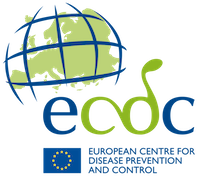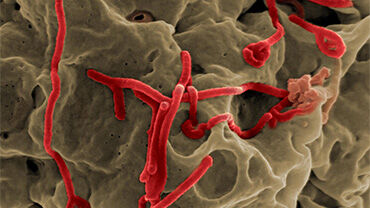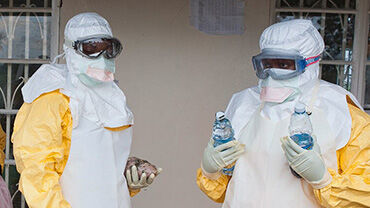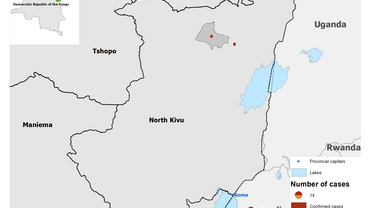Epidemiological update: Outbreak of Ebola virus disease in West Africa, 29 January 2015
According to WHO, a combined total of 99 confirmed cases were reported from the three countries with widespread and intense transmission in the week ending 25 January: 30 in Guinea, four in Liberia, and 65 in Sierra Leone.
According to WHO, a combined total of 99 confirmed cases were reported from the three countries with widespread and intense transmission in the week ending 25 January: 30 in Guinea, four in Liberia, and 65 in Sierra Leone.
On 29 January 2015, WHO has reported 22 136 confirmed, probable, and suspected cases of Ebola virus disease, with 8 833 deaths, in three affected countries (Guinea, Liberia and Sierra Leone) and five previously affected countries (Mali, Nigeria, Senegal, Spain and the United States of America).
According to WHO, the response to the EVD epidemic has now moved to a second phase, as the focus shifts from slowing transmission to ending the epidemic.
Distribution of cases
Countries with widespread and intense transmission:• Guinea: 2 921 cases and 1 911 deaths (as of 26 January 2015); • Liberia: 8 643 cases and 3 700 deaths (as of 26 January 2015);• Sierra Leone: 10 537 cases and 3 199 deaths (as of 25 January 2015).
Countries with an initial case or cases, or with localised transmission:• United Kingdom: one confirmed case on 29 December 2014;• United States: four cases including one death. The last case tested negative on 11 November 2014 in New York; • Mali: eight cases, six deaths. According to WHO, Mali has been declared Ebola free on 18 January 2015;• Nigeria, Senegal and Spain have been declared free of EVD after having cases related to the current epidemic in West Africa.
Figure 1. Distribution of cases of EVD by week of reporting in Guinea, Sierra Leone, Liberia, Nigeria, Senegal and Mali, weeks 48/2013 to 05/2015, as of 26 January 2015.
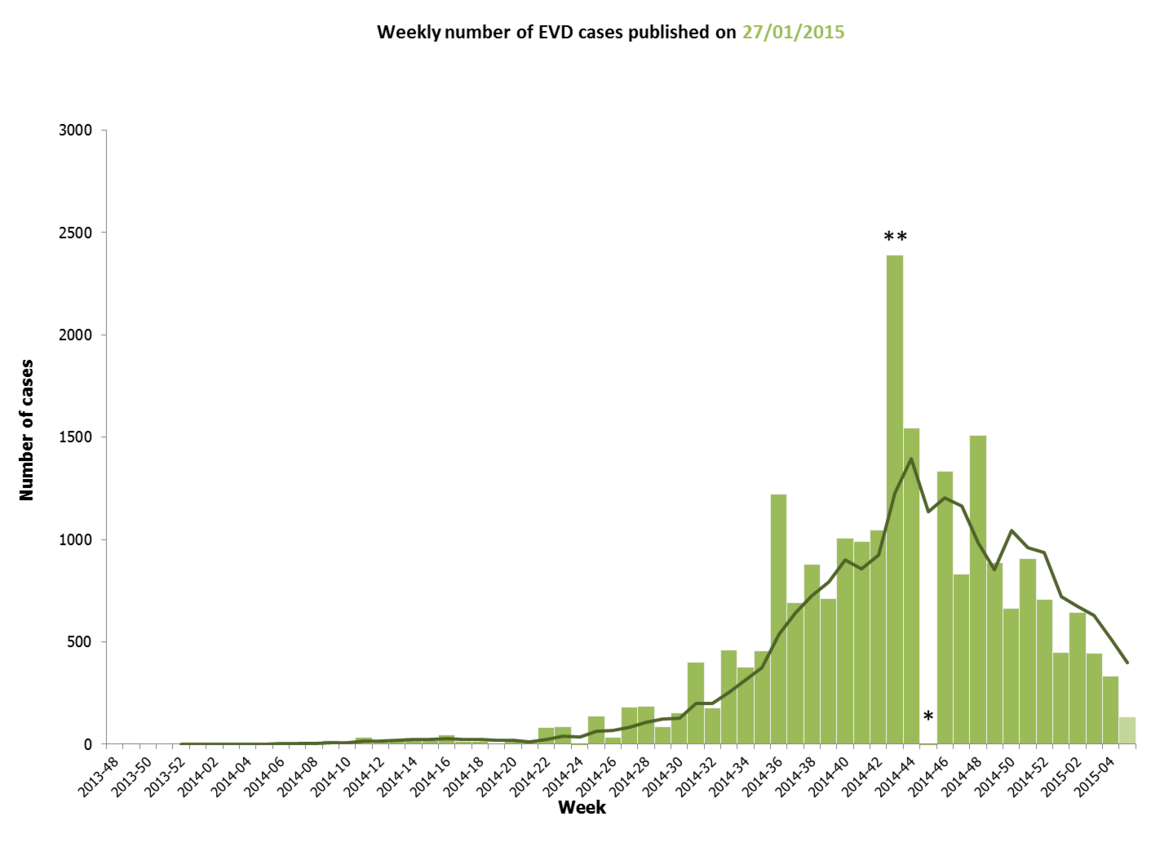
* In week 45/2014, the WHO carried-out a retrospective correction in the data resulting in reporting 299 fewer cases resulting in a negative value for new cases in week 45 which is not plotted. .
** According to the WHO the marked increase in the cumulative total number of cases in week 43 is due to a more comprehensive assessment of patient databases leading to 3 792 additional reported cases. However, these cases have occurred throughout the epidemic period. The green line represents the trend based on a five week moving average plotted on the fifth week of the moving average window. The figure includes cases in Nigeria (20), Senegal (1) and Mali (4). http://apps.who.int/iris/bitstream/10665/144498/1/roadmapsitrep_26Nov2014_eng.pdfua=1
Situation in the affected West African countries
According to WHO, case incidence continues to fall in all the intense transmission countries and all three have sufficient capacity to isolate and treat patients, with more than two treatment beds per reported confirmed, probable and suspected case. The planned numbers of beds in each country has now been reduced in accordance with falling case incidence. Between 89% and 99% of registered contacts are being monitored in the three countries with intense transmission, though the number of contacts traced per EVD case remains lower than expected in many districts. Since the beginning of 2015, around 50% of new confirmed cases in Guinea and Liberia arose from known contacts; equivalent data are not yet available for Sierra Leone.
The cumulative case-fatality rate in the three transmission-intense countries among hospitalised patients is between 54 and 62%. According to WHO, a total of 27 sub-prefectures in Guinea reported at least one security incident or other form of refusal to cooperate in the week up to 21 January. A total of two districts in Liberia and four districts in Sierra Leone reported at least one similar incident during the same reporting period.
MaliOn 18 January 2015, the Government of Mali and WHO declared the country Ebola free, 42 days after the last patient tested negative on 6 December 2014.
Figure 2. Distribution of cases of EVD by week of reporting, Guinea, Liberia and Sierra Leone, as of week 05/2015.
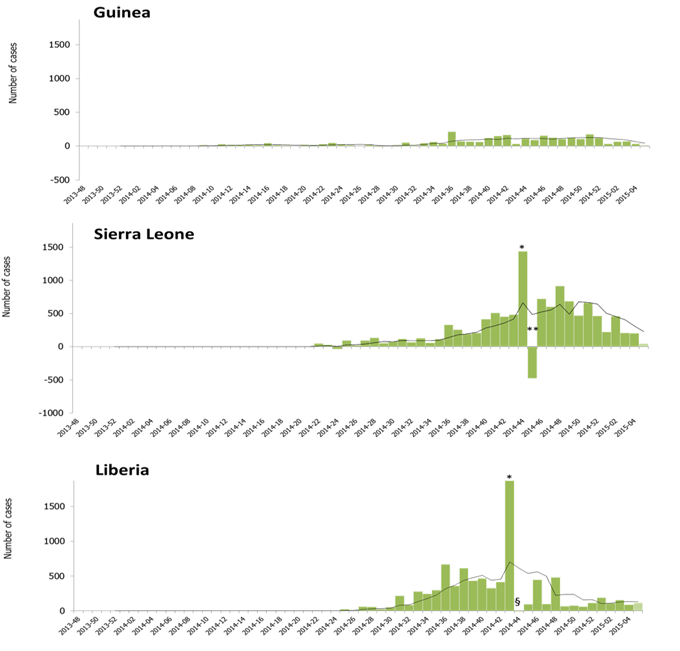
* The marked increase in the number of cases reported in Sierra Leone (week 44) and Liberia (week 43) results from a more comprehensive assessment of patient databases. The additional 3 792 cases have occurred throughout the epidemic period. Source: Data are based on official information reported by ministries of health up to the end of 2 November for Guinea and Sierra Leone and 31 October for Liberia. http://apps.who.int/iris/bitstream/10665/137510/1/roadmapsitrep_5Nov14_eng.pdf** In week 45/2014, WHO reported 476 fewer cases than the week before in Sierra Leone due to retrospective corrections. § In week 44/2014, WHO reported zero cases for Liberia.
Figure 3. Distribution of cases of EVD by week of reporting in Guinea, Sierra Leone, Liberia and Mali (as of week 04/2015).

Source: Data from ministries of health reports (suspected, probable and confirmed cases).
Situation among healthcare workers
Up to the end of 25 January 2015, 834 healthcare workers (HCWs) are known to have been infected with EVD, 495 of whom have died.
Distribution of cases: 162 HCWs in Guinea, 371 HCWs in Liberia, 283 HCWs in Sierra Leone, two HCWs in Mali, 11 HCWs infected in Nigeria, one HCW infected in Spain while treating an EVD-positive patient, one HCW in the UK who became infected in Sierra Leone, and three HCWs in the USA (one HCW infected in Guinea, and two HCWs infected during the care of a patient in Texas).
Table 1. Number of Ebola cases and deaths among healthcare workers, as of 28 January 2015
| Country | Healthcare worker cases | Healthcare worker deaths |
|---|---|---|
| Guinea | 162 | 88 |
| Liberia | 371 | 179 |
| Mali | 2 | 2 |
| Nigeria | 11 | 5 |
| Sierra Leone | 283 | 221 |
| Spain | 1 | 0 |
| UK | 1 | 0 |
| United States | 3 | 0 |
| Total | 834 | 495 |
Source: Data are based on official information reported by Ministries of Health. http://apps.who.int/iris/bitstream/10665/150249/1/roadmapsitrep28Jan15_eng.pdfua=1&ua=1&ua=1
Situation outside West Africa
United KingdomOne case was reported in Scotland in a patient who travelled from Sierra Leone via Casablanca and London and arrived in Glasgow late on 28 December 2014. Media report that the Scottish nurse has been discharged from hospital on 24 January 2015, after being declared free of the virus.
Public Health England has completed contact tracing following this confirmed case of Ebola. No high-risk contacts have been identified in connection with the case.
Medical evacuations and repatriations from EVD-affected and previously affected countries
Thirty-two individuals have been evacuated or repatriated from the EVD-affected countries. As of 28 January, there have been 13 medical evacuations of confirmed EVD-infected patients to Europe (three to Germany, three to Spain, two to France, one to the UK, one to Norway, one to Italy, one to the Netherlands and one to Switzerland). Nine persons exposed to Ebola who then tested negative have been repatriated to Europe (two to Sweden, two to UK, two to the Netherlands, one to Denmark, one to Germany and one to Switzerland).
According to media, a Red Cross aid worker who got in contact with EVD in Sierra Leone has been medically evacuated to Sweden. The woman does not present any symptoms and has already been discharged. Results of the tests are still pending.
Figure 4. Medical evacuations and repatriations from EVD-affected and previously affected countries, as of 28 January 2015.
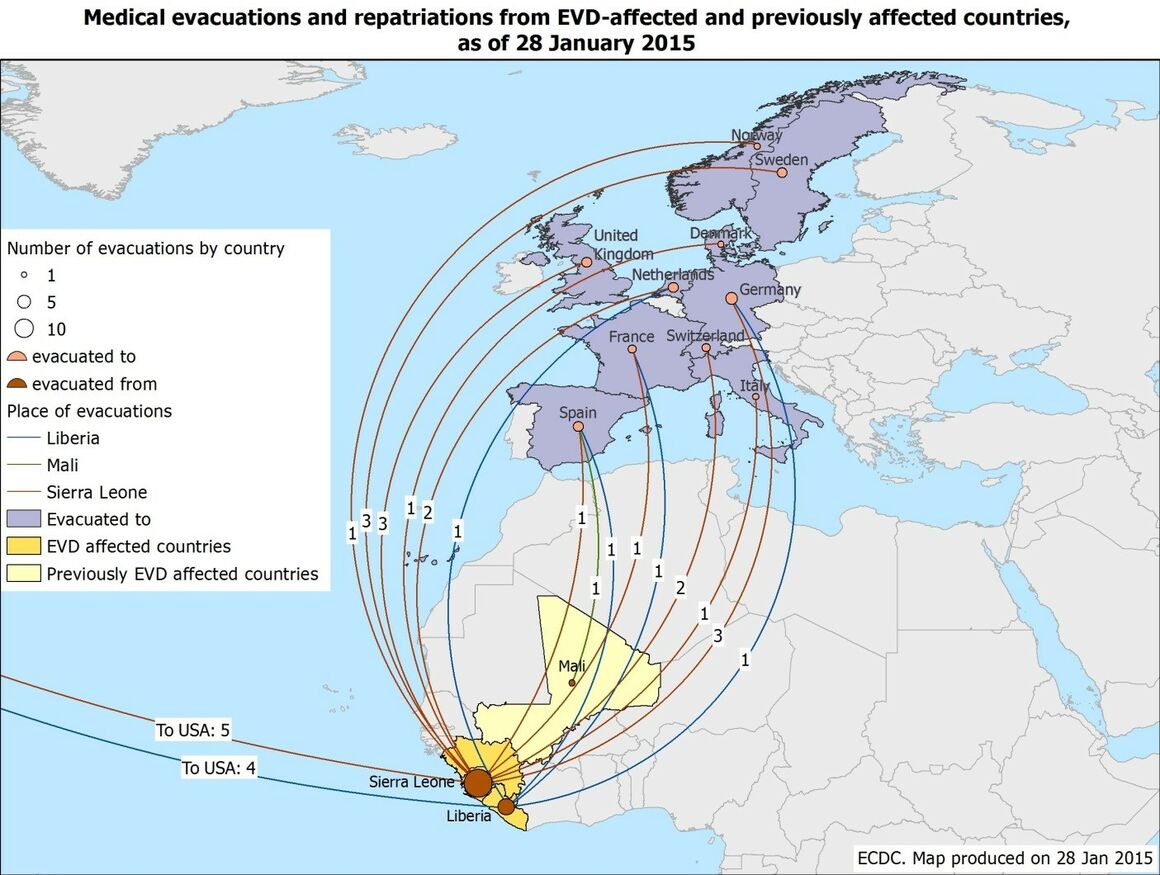
ECDC Assessment
This is the largest ever documented epidemic of EVD in terms of numbers and geographical spread. The evolving epidemic of EVD increases the likelihood that EU residents and travellers to the EVD-affected countries will be exposed to infected or ill persons.
The risk of infection for residents and visitors in the affected countries through exposure in the community is considered low if they adhere to the recommended precautions. Residents and visitors to the affected areas run a risk of exposure to EVD in healthcare facilities.
The level of this risk is related to how well the infection control measures are being implemented in these settings and the nature of the care required.
As the epidemic is still evolving and more international staff is deployed to the affected countries to support the epidemic control, there remains a risk of importation of EVD cases to the EU.
The risk of Ebola virus spreading from an EVD patient who arrives in the EU as result of a planned medical evacuation is considered to be low when appropriate measures are strictly adhered to, but cannot be excluded in exceptional circumstances.
If a symptomatic case of EVD presents in an EU Member State, secondary transmission to caregivers in the family and in healthcare facilities cannot be excluded. The highest risk is at an early stage of the disease, before the risk of EVD has been recognised and at the late stage of the disease when patients have very high viral loads and undergo invasive therapeutic procedures.
